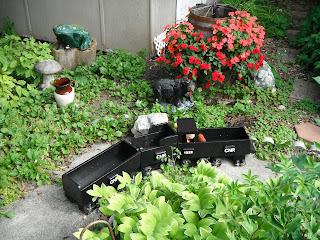The other day I put up another motion sensitive light, this time under the front porch overhang. What is the best way to drill two holes into brick? A hammer drill and carbide drill bit. I don't think a house hold should be without a hammer drill and bits. I have drilled dozens of holes in bricks and blocks for shelves, lights and all sorts of other stuff. It also helps to have a proper five foot step ladder when doing this sort of job.
Here is another goofy little project. I call it grey leather, double thickness duct tape. In this case I put wooden ends into the "leather" pouch. I made this to hold my various 'card' wallets together in my bag, or glove box, or where ever. It was really nice to have work space and a very sharp knife to make this thing. To make it slightly ridged I put several narrow pieces of veneer between the layers of duct tape.
Yesterday Kieran made a robot in the shop, one that shoots a torpedo . Last time K was here he began using the jig saw, this time he got to paint using a "rattle can". The paint job he achieved with the spray can was many times better than he has ever achieved with a brush. Many of the bits and pieces are glued on using a hot glue gun, while there are holes drilled for the bolts. K used the cordless drill with the key less chuck and drill bits to make holes of various sizes.
Wet season is coming. I replaced a couple of broken dowels on my boot dryer, I made mine but there are several to choose from at thetoolstore.ca . Last year I bought the multi hole one for the grand kids. We don't get our boots wet much anymore, so two spots are enough.

Here are a two repairs for 10,000 Villages. I had a bird with a broken neck and a lady with a broken arm. This time neither repair will be invisible but when I am done the repair shouldn't to too obvious. The bird fell and broke its neck because the base was way off level, I've wedged it and it glued the broken neck, I hope it finds a nice quiet home somewhere.
These are my finished carvings for entry in the Rockton Worlds Fair next weekend. Lots of finish sanding and two coats of spray vanish. I hope they show well at the fair.
There have been pictures to frame and walls to repair (we moved a bunch of pictures so had lots of holes to fill) as well as getting out in the lovely fall weather because you know it won't last. Busy, busy and mostly loving it.
cheers, ianw








































